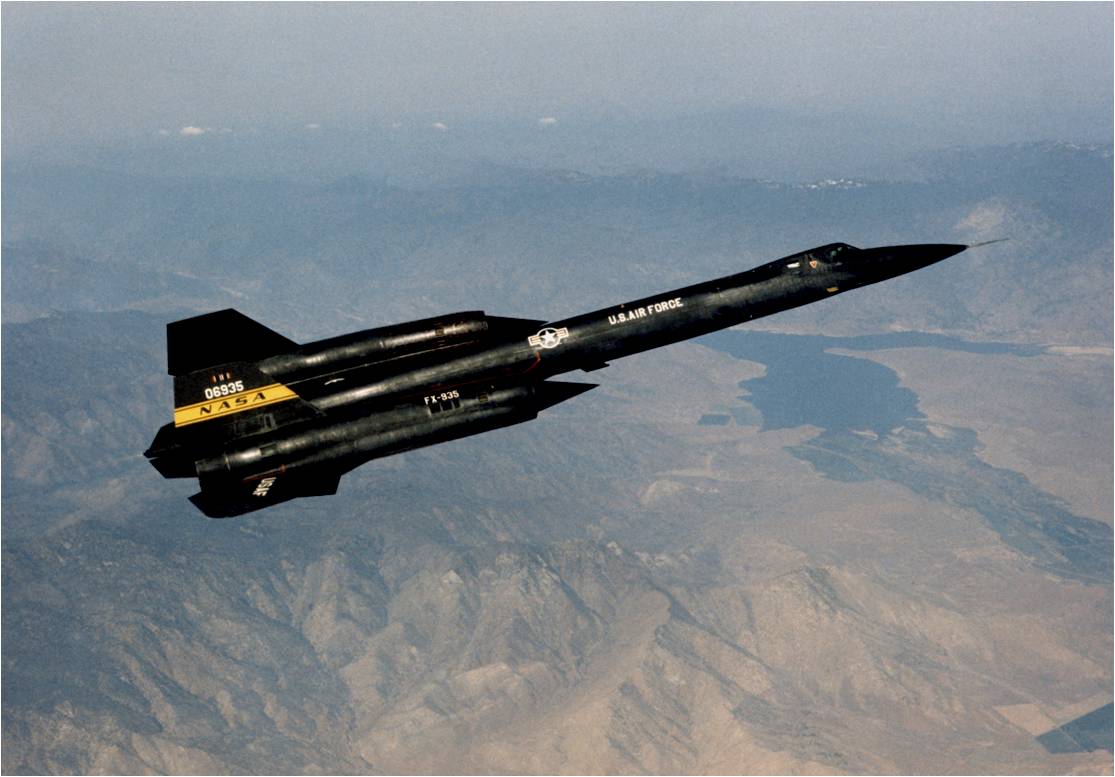Thirty-one years ago this month, the 2nd and only surviving USAF/Lockheed YF-12A completed its final NASA flight research mission. The flight brought to a close the 10-year period within which the YF-12A was employed as a NASA high-speed flight research platform.
The YF-12A was the interceptor variant of the vaunted Lockheed A-12 Mach 3+ aircraft. Armed with a quartet of Hughes AIM-47A air-to-air missiles, the YF-12A’s mission would be to intercept and destroy incoming Soviet bombers. Lockheed proposed the A-12 variant as a cost-effective replacement for the defunct North American XF-108 Rapier.
The YF-12A differed from the A-12 in that a second crew station was added for the AIM-47A Weapons Systems Officer (WSO). The WSO operated the powerful Hughes AN/ASG-18 fire control radar which had a range on the order of 500 miles. The YF-12A’s forebody chines were truncated back of the axisymmetric nose to accommodate the radar system. Infrared (IR) sensors were installed on the leading edges of the shortened chines.
The Hughes AIM-47A missile measured 12.5 feet in length and 13.5 inches in diameter. Maximum range of the 800-pound missile was in excess of 100 miles. While the type’s intended maximum Mach number was 6, propulsion system development problems limited the demonstrated maximum Mach number to 4. About eighty (80) AIM-47A missiles were produced. Seven (7) of these rounds were test fired in flight. All but one (1) was successful.
Lockheed converted a trio of A-12 aircraft to the YF-12A configuration. The YF-12A aircraft were assigned serial numbers 60-6934 (Ship 1), 60-6935 (Ship 2) and 60-6936 (Ship 3). Ship 1 made the maiden YF-12A flight from Groom Lake, Nevada on Wednesday, 07 August 1963 with James D. Eastham at the controls.
Over the next eighteen (18) months, all three (3) YF-12A aircraft were put through performance flight testing at Groom Lake. Ship 3 set a number of speed and altitude records on Saturday, 01 May 1965. Included was the first air-breathing aircraft speed record in excess of 2,000 mph (2,070.102 mph) and a sustained altitude record of 80,257.86 feet above mean sea level.
USAF liked the YF-12A’s demonstrated performance capabilities. Thus, on Friday, 14 May 1965, the service ordered ninety-three (93) units of the production YF-12A aircraft known as the F-12B. Congress approved the order and allotted $90M to get production going. Unfortunately, United States Secretary of Defense Robert S. McNamara nixed the deal and cancelled the production of the F-12B.
Recall that McNamara also cancelled the XB-70A and X-20A Dyna-Soar and was the genius who championed the ill-posed TFX multiservice aircraft concept. He was also responsible for crafting the absurd rules of air war engagement that resulted in the inordinately large and unnecessary losses of American pilots in Viet Nam. McNamara further cemented his status as the Bane of the U.S. Air Force with the F-12B production wave-off.
Following the F-12B cancellation, YF-12A flight testing by USAF continued through 1969. One aircraft was lost along the way. On Thursday, 14 August 1966, Ship 1 was severely damaged in a landing incident at Edwards AFB and never flew again. Happily, the crew escaped injury.
In December of 1969, NASA initiated a flight research effort using YF-12A Ship 2 and Ship 3. Over the next ten (10) years a wealth of aerodynamic, aero heating, structural and propulsion flight research data were acquired using these unique high-speed assets. A great benefit in this regard was the type’s ability to sustain Mach 3+ flight conditions for periods up to 15 minutes per mission.
YF-12A Ship 3 was lost on Thursday, 24 June 1971 when an inflight fire started due to a failed fuel line in the right-hand J58 turbo-ramjet engine. The USAF crew of pilot Lt Col Ronald J. Layton and WSO Maj William A. Curtis attempted to recover the aircraft to Edwards AFB. However, the fire quickly spread and forced the crew to abandon the aircraft. They ejected safely and survived. Ship 3 was making its 67th flight of the NASA YF-12A flight research effort at the time of its demise.
Following Ship 3’s loss, Ship 2 flew the remainder of the NASA YF-12A high-speed flight research program. It registered a total of 146 missions in that capacity. On Wednesday, 07 November 1979, YF-12A Ship 2 departed Edwards AFB for its final destination; the USAF Musuem at Wright-Patterson AFB, Ohio. The USAF crew consisted of pilot Col James V. Sullivan and USAF Museum Director Richard Uppstrom as the guy in back (GIB).
As a footnote to the current story, the USAF attempted throughout the 1950’s and 1960’s to develop and produce a Mach 3 interceptor. Notable abortive attempts include the Republic XF-103 Thunder Warrior, the North American XF-108 Rapier and the Lockheed F-12B. Doubtless, there have been failed black-world attempts as well. The net result is that a Mach 3 interceptor has yet to grace the USAF production aircraft inventory.



Comments
I few years ago I was fortunate enough to spend some time in the Experimental Hangar at the USAF Museum at Wright Patt where ship 2 currently resides. On that aircraft I noticed that there was a ventral fin on the underside of the aft body. It was particularly interesting because it hinged at the root so it could lay across the body. I assume this was so the aircraft could rotate during take off. To my knowledge, A-12s and SR71s don’t have this fin. Do you know the impetus for this feature?
P.S. I love the site.
Share this post: